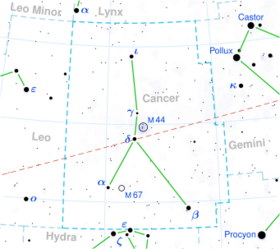Astronomy:Xi Leonis
From HandWiki
Short description: Star in the constellation Leo
| Observation data Epoch J2000.0 Equinox (celestial coordinates) | |
|---|---|
| Constellation | Leo |
| Right ascension | 09h 31m 56.74097s[1] |
| Declination | +11° 17′ 59.3585″[1] |
| Apparent magnitude (V) | 4.97[2] |
| Characteristics | |
| Evolutionary stage | red clump[3] |
| Spectral type | K0 III[4] |
| U−B color index | +0.88[2] |
| B−V color index | +1.04[2] |
| Variable type | suspected[5] |
| Astrometry | |
| Radial velocity (Rv) | 34.85±0.26[6] km/s |
| Proper motion (μ) | RA: −101.446[1] mas/yr Dec.: −82.543[1] mas/yr |
| Parallax (π) | 14.2602 ± 0.1106[1] mas |
| Distance | 229 ± 2 ly (70.1 ± 0.5 pc) |
| Absolute magnitude (MV) | 0.663[3] |
| Details | |
| Mass | 2.8[1] M☉ |
| Radius | 12[7] R☉ |
| Luminosity | 60[7] L☉ |
| Surface gravity (log g) | 2.7[7] cgs |
| Temperature | 4,688[7] K |
| Metallicity [Fe/H] | −0.17[7] dex |
| Rotational velocity (v sin i) | 1.0[8] km/s |
| Age | 3.89±2.03[3] Gyr |
| Other designations | |
| Database references | |
| SIMBAD | data |
Xi Leonis (ξ Leo, ξ Leonis) is a solitary star in the zodiac constellation of Leo. It has an apparent visual magnitude of 5.0 and is faintly visible to the naked eye. The distance to this star, as determined by parallax measurements, is roughly 229 light years.
This is an evolved, K-type giant star with a stellar classification of K0 III.[4] At an age of around four billion years, it has expanded to 12 times the radius of the Sun and shines with 60 times the Sun's luminosity. The effective temperature of the star's outer atmosphere is 4,688.[7] In the General Catalogue of Variable Stars, it is listed as a suspected variable star based on a 1929 paper.[5]
References
- ↑ 1.0 1.1 1.2 1.3 1.4 1.5 Vallenari, A. et al. (2022). "Gaia Data Release 3. Summary of the content and survey properties". Astronomy & Astrophysics. doi:10.1051/0004-6361/202243940 Gaia DR3 record for this source at VizieR.
- ↑ 2.0 2.1 2.2 Paczynski, B. et al. (September 1999), "The Optical Gravitational Lensing Experiment. UBVI Photometry of Stars in Baade's Window", Acta Astronomica 49: 319–339, Bibcode: 1999AcA....49..319P.
- ↑ 3.0 3.1 3.2 Soubiran, C. et al. (2008), "Vertical distribution of Galactic disk stars. IV. AMR and AVR from clump giants", Astronomy and Astrophysics 480 (1): 91–101, doi:10.1051/0004-6361:20078788, Bibcode: 2008A&A...480...91S.
- ↑ 4.0 4.1 Eggen, O. J. (1962), "Space-velocity vectors for 3483 stars with proper motion and radial velocity", Royal Observatory Bulletin 51: 79, Bibcode: 1962RGOB...51...79E.
- ↑ 5.0 5.1 Samus, N. N.; Durlevich, O. V. et al. (2007), Combined General Catalogue of Variable Stars (GCVS4.2), http://www.sai.msu.su/gcvs/gcvs/, retrieved 2016-09-30. VizieR On-line Data Catalog: B/gcvs.
- ↑ Famaey, B. et al. (2005), "Local kinematics of K and M giants from CORAVEL/Hipparcos/Tycho-2 data. Revisiting the concept of superclusters", Astronomy and Astrophysics 430: 165–186, doi:10.1051/0004-6361:20041272, Bibcode: 2005A&A...430..165F.
- ↑ 7.0 7.1 7.2 7.3 7.4 7.5 Massarotti, Alessandro et al. (January 2008), "Rotational and radial velocities for a sample of 761 HIPPARCOS giants and the role of binarity", The Astronomical Journal 135 (1): 209–231, doi:10.1088/0004-6256/135/1/209, Bibcode: 2008AJ....135..209M.
- ↑ Glebocki, R.; Gnacinski, P. (2005), "VizieR Online Data Catalog: Catalog of Stellar Rotational Velocities (Glebocki+ 2005)", VizieR On-line Data Catalog: III/244. Originally Published in: 2005csss...13..571G; 2005yCat.3244....0G 3244, Bibcode: 2005yCat.3244....0G.
- ↑ "* ksi Leo". SIMBAD. Centre de données astronomiques de Strasbourg. http://simbad.u-strasbg.fr/simbad/sim-basic?Ident=%2A+ksi+Leo.
External links
 |


